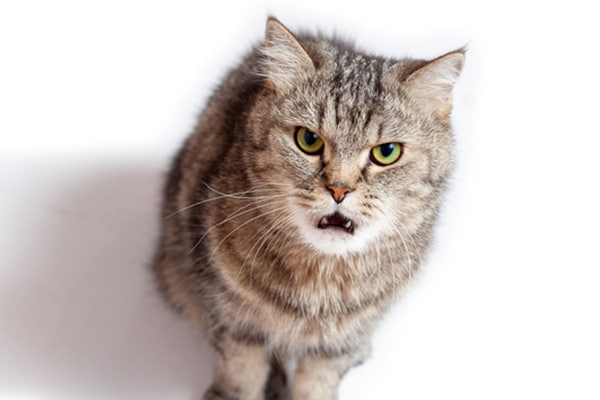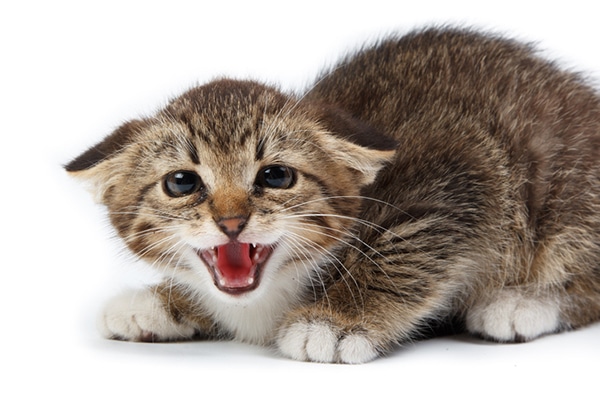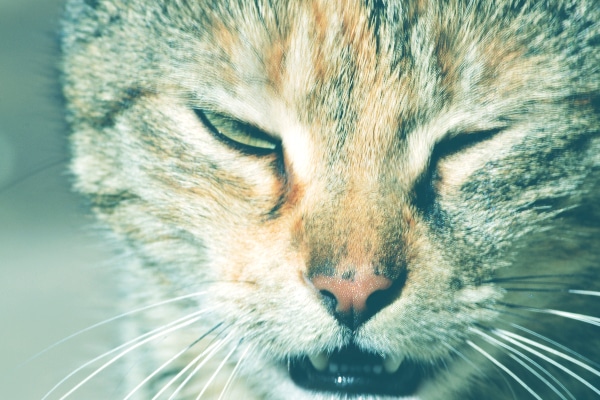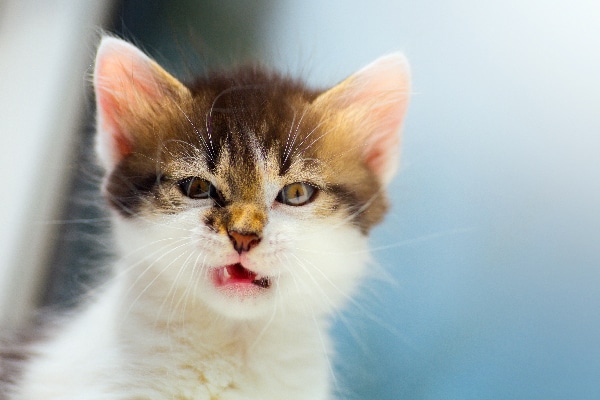The other day I was making breakfast when I heard a familiar sound coming from the living room — a low-pitched grumble, not unlike the sound a monster makes in a horror movie. The sound quickly escalated to a yowl, followed by claws scraping along the wood floor. I had not, in fact, accidentally raised an ancient ghoul — it was just my young cat, Salvypoo, “playing” with my cranky old calico, Phoenix, who was utilizing some angry cat sounds to express her displeasure with her hyperactive sibling.
While not as pleasant as a gentle purr or an inquisitive meow, angry cat sounds are an unmistakable and important way your kitty communicates. Recognizing when your cat is angry and being aware of why it happens will help you know when she needs time to decompress — and may prevent you from an accidental scratch or cat bite injury.
Angry cat sounds — growling means back off
Growling is often the first audible clue that your cat is angry. When Phoenix gets mad, she first communicates with body language — ears down, eyes wide, tail flailing from side to side. Then comes the growl, starting as a low-pitched grumble like angry Marge Simpson and quickly building to a yowl if whatever is ticking her off does not back the heck off.
For many cats, growling is just that — a warning noise that likely stems from annoyance, anger, aggression or fear. If your cat is growling, it’s probably wise to take a breather before attempting to pet her or pick her up to calm her down.
Angry cat sounds — Growls are sometimes accompanied by angry meows

Growling can often be accompanied by an angry meow, which sounds like a regular meow filled with gravel and steroids. The angry meow can also be used as a kind of exclamation point, punctuating the growl as if to say, “And I mean it.” When the meow becomes high-pitched and multisyllabic, that indicates the cat is especially stressed.
Angry cat sounds — Hissing means back off, for real
Cats can hiss for lots of reasons, but if your cat is hissing because she’s angry, it’s pretty much the equivalent of you spewing a stream of curse words at the jerk who just cut you off in rush-hour traffic — that is, your kitty is making this sound because she’s darn mad, or more likely some combination of confused, frustrated and afraid. Hissing is a cat’s instinctual response to something he perceives as a threat, which could be as intimidating as a shot-wielding veterinarian or as mundane as another pet scooting too close to him on the couch.
In any case, hissing is among the angry cat sounds that warn. Basically, it’s the feline equivalent of a middle finger, meaning this angry cat is ready to fight. When Phoenix hisses, a swipe of her paw with claws extended is soon to follow. Don’t approach a hissing cat. Instead, it’s best to give him some space until he calms down and feels safe again.
Angry cat body language

In addition to angry cat sounds like hisses, growls and angry meows, you can tell your cat is angry by paying attention to her body language. I’ll use Phoenix as an example. When she’s calm, she’s the sweetest kitty on the planet — very gentle, inquisitive and affectionate. I have a nine-month-old son, and she will let him pet and squeeze her without any hint of annoyance. During these interactions, her ears are upright, her eyes are squinted in a “smile,” and her tail is either raised or flicking casually from side to side. If she vocalizes, it’s likely to be an insistent meow begging for more chin scritchies.
When Salvypoo playfully attacks her, though, Phoenix’s body language completely changes. Her ears flatten against her head, her pupils dilate, her shoulders hunch and her tail twitches violently – or puffs up if she’s especially angry or afraid. She also reacts this way to the vacuum cleaner.
How should you respond to angry cat sounds?

When dealing with an angry cat, it’s always better to be safe than sorry. When threatened, cats are running on adrenaline and instinct, which means anyone — even a safe, familiar cat parent — is likely to get injured if they approach. Your best move is simply to walk away. If possible, leave the room — or allow the cat to leave the room and retreat somewhere quiet, away from whatever she perceives to be the threat.
Never punish a cat for being angry. Instead, give your kitty some time to cool down, and instead of approaching your cat, wait for her to come to you. Before you know it, she’ll be curled up purring in your lap again, making much friendlier sounds.
Thumbnail: Photography ©Konstanttin | iStock / Getty Images Plus.
Read more about cat behavior on Catster.com:








